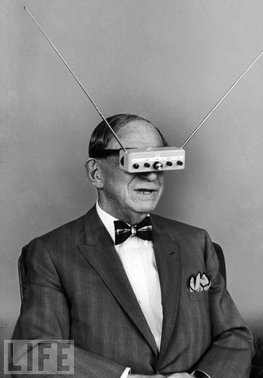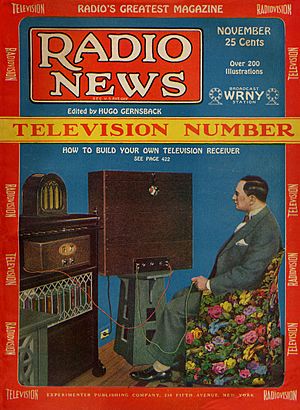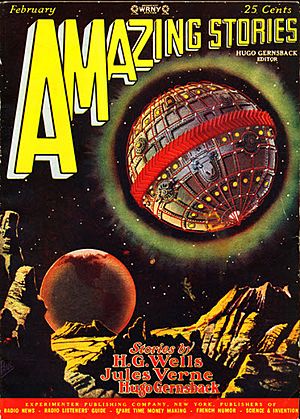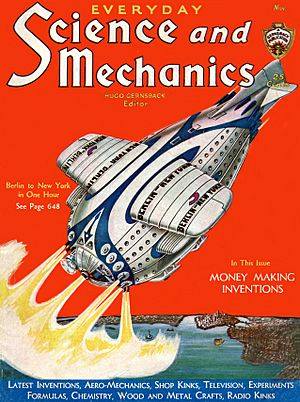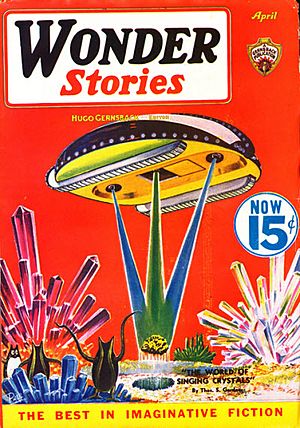Hugo Gernsback facts for kids
Quick facts for kids
Hugo Gernsback
|
|
|---|---|
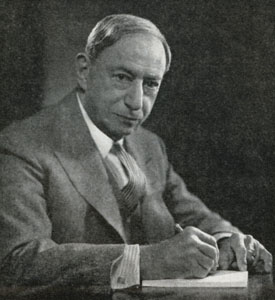
Gernsback portrait by Fabian, date unknown
|
|
| Born | Hugo Gernsbacher August 16, 1884 Luxembourg City, Luxembourg |
| Died | August 19, 1967 (aged 83) Manhattan, New York City |
| Pen name | Beno Ruckshagg, Erno Shuckbagg, Grace G. Hucksnob, Grego Banshuck, Greno Gashbuck, Gus N. Habergock, Kars Gugenchob |
| Occupation |
|
| Nationality | Luxembourgish, American |
| Period | 1911–1967 (science fiction) |
| Genre | Science fiction |
Hugo Gernsback (born Hugo Gernsbacher, August 16, 1884 – August 19, 1967) was an important editor and publisher from Luxembourg and America. He created the very first science fiction magazine. Because of his big impact on science fiction, many people call him "The Father of Science Fiction." He is often mentioned alongside famous writers like H. G. Wells and Jules Verne.
To honor him, the annual awards given at the World Science Fiction Convention are called the "Hugos."
Contents
- Hugo Gernsback's Early Life and Radio Adventures
- Hugo Gernsback and the Birth of Science Fiction
- Hugo Gernsback's Own Stories
- Hugo Gernsback's Lasting Impact
- Hugo Gernsback's Influence in Radio and Electronics
- Magazines Edited or Published by Hugo Gernsback
- Hugo Gernsback's Inventions and Patents
- See also
Hugo Gernsback's Early Life and Radio Adventures
Hugo Gernsback was born in 1884 in Luxembourg City. His parents were Berta and Moritz Gernsbacher. In 1904, Gernsback moved to the United States. He later became an American citizen.
He married three times during his life. In 1925, he started a radio station called WRNY. This station broadcast from the Roosevelt Hotel in New York City. In 1928, WRNY even aired some of the first television broadcasts. Gernsback is also known as a pioneer in amateur radio.
Before he helped create science fiction, Gernsback was a businessman in electronics. He brought radio parts from Europe to the U.S. He also helped make amateur "wireless" popular. In 1908, he started Modern Electrics. This was the world's first magazine about electronics and radio.
In 1909, he founded the Wireless Association of America. Within a year, it had 10,000 members. By 1912, Gernsback thought about 400,000 people in the U.S. were involved in amateur radio. In 1913, he started another magazine, The Electrical Experimenter. This magazine later became Science and Invention in 1920.
It was in these magazines that he began to include science fiction stories. He published his own novel, Ralph 124C 41+, in Modern Electrics starting in 1911. Hugo Gernsback also launched Radio News magazine in 1919 for radio fans. He passed away in New York City in 1967 at age 83.
Hugo Gernsback and the Birth of Science Fiction
In 1926, Gernsback created a special place for modern science fiction. He started Amazing Stories, the first magazine just for this type of writing. The first issue had an editorial and six stories. Some were new, and some were by famous authors like Poe, Verne, and Wells.
Gernsback said he became interested in science fiction after reading about Percival Lowell as a child. He believed a perfect science fiction story should be "75 percent literature interwoven with 25 percent science." He also helped start science fiction fandom. He did this by creating the Science Fiction League. He also published the addresses of people who wrote letters to his magazines. This helped fans connect and become a community.
In 1929, Gernsback came up with the term "science fiction." Before that, he preferred to call the genre scientifiction.
After losing control of Amazing Stories in 1929, Gernsback started two new science fiction magazines. These were Science Wonder Stories and Air Wonder Stories. A year later, they combined to form Wonder Stories. He published this magazine until 1936. Gernsback returned to science fiction publishing in 1952 with Science-Fiction Plus.
Hugo Gernsback's Own Stories
The author Frederik Pohl once said that Gernsback's magazine Amazing Stories published stories like Gernsback himself wrote. These were often like a "catalogue of gadgets."
Gernsback's most famous novel is Ralph 124C 41+. The title is a clever way of saying "one to foresee for many." Many people think this book introduced many ideas and themes found in later science fiction. However, some critics found the writing quality to be not very good. Still, science fiction expert Gary Westfahl calls it an "essential text" for studying science fiction.
His second novel, Baron Münchausen's Scientific Adventures, was published in Amazing Stories in 1928. Gernsback's third and final novel, Ultimate World, was written around 1958 but published in 1971.
Gernsback also combined his stories and science in Everyday Science and Mechanics magazine. He was the editor of this magazine in the 1930s.
Hugo Gernsback's Lasting Impact
In 1954, Gernsback received a special honor from Luxembourg. He was made an Officer of the Order of the Oak Crown. This is like being knighted.
The Hugo Awards, or "Hugos," are very important awards in science fiction. They are given out every year at the World Science Fiction Convention. Fans vote for the winners. These awards started in the 1950s and were named "Hugos" to honor Hugo Gernsback.
In 1960, Gernsback received a special Hugo Award. It recognized him as "The Father of Magazine Science Fiction." In 1996, he was inducted into the Science Fiction and Fantasy Hall of Fame. He was part of the very first group of people to be honored there.
Hugo Gernsback's Influence in Radio and Electronics
Gernsback greatly helped the early growth of radio broadcasting. He did this mostly through his magazines. He started the idea of special magazines for radio with Modern Electrics and Electrical Experimenter. Later, he published Radio News, which became the most popular radio magazine during radio's early years. He edited Radio News until 1929.
Gernsback used his magazines to promote his interests. For example, his radio station's call letters were on the cover of Radio News starting in 1925. WRNY and Radio News helped each other. Programs on his station often talked about articles he had published. Articles in the magazine often covered what was happening at WRNY.
He also pushed for new ideas and rules in radio. His magazine had many drawings and diagrams. These encouraged radio listeners in the 1920s to experiment and improve the technology themselves. WRNY was often used as a laboratory to test new radio inventions.
Articles about television were also tested this way. In August 1928, the radio station sent pictures to experimental television receivers. However, the technology could only send sight and sound one after the other. This was because WRNY only broadcast on one channel. These experiments were expensive. WRNY was later sold to another company.
Magazines Edited or Published by Hugo Gernsback
- Air Wonder Stories (1929–1930)
- Amazing Detective Stories
- Amazing Stories
- Aviation Mechanics
- Electrical Experimenter (1913–1920)
- Everyday Science and Mechanics (from 1929)
- The Experimenter (from 1924)
- Facts of Life
- Fotocraft
- Gadgets
- High Seas Adventures
- Know Yourself
- Life Guide
- Light
- Modern Electrics (1908–1914)
- Moneymaking
- Motor Camper & Tourist
- New Ideas for Everybody
- Pirate Stories
- Popular Medicine
- Popular Microscopy
- Practical Electrics (1921–1924)
- Radio Amateur News (1919–1920)
- Radio and Television
- Radio-Craft (1929–1948)
- Radio-Electronics (1948–2003)
- Radio News (1919–1948)
- Radio Program Weekly
- Radio Review
- Science and Invention (1920–1931)
- Science and Mechanics (from 1931)
- Science Fiction Plus (1953)
- Science Wonder Stories (1929–1930)
- Science Wonder Quarterly (1929–1930)
- Scientific Detective Monthly
- Short-Wave and Television
- Short-Wave Craft
- Short-Wave Listener
- Superworld Comics
- Technocracy Review
- Television (1928)
- Television News (1931–1932)
- Tidbits
- Woman's Digest
- Wonder Stories (1930–1936)
- Your Body
- Your Dreams
Hugo Gernsback's Inventions and Patents
Hugo Gernsback held 80 patents by the time he passed away in 1967. His first patent was for a new way to make dry-cell batteries. He applied for this patent in 1906, and it was granted in 1907.
Some of his interesting inventions include:
- A brush and comb that worked together with electricity (1912).
- An ear cushion (1927).
- A special hydraulic fishing device (1955).
Other patents he held were for things like lamps, regulators, condensers, relays, and various radio and electrical devices. He also patented a depilator (hair removal device) and a code learner's instrument.
See also
 In Spanish: Hugo Gernsback para niños
In Spanish: Hugo Gernsback para niños
- List of science fiction editors
- Pulp magazine


